Occasionally, we tend to look at the mirror and contemplate the “flaws” within any part of our body. We may have negative thoughts about a certain body part. These acts are completely normal, as we cannot always admire our body every single day. People diagnosed with body dysmorphia (BDD) would have reoccurring thoughts and behaviors that are extremely overwhelming compared to the previously mentioned ones. Body dysmorphia is not a phase or a simple problem that can be resolved by “loving your body”. It is a mental illness that renders your appearance obstruct your daily tasks. BDD and eating disorders have a correlation, but they do not relatively focus on the same thing. The main distinction between them is that a person with an eating disorder mostly worries about their weight, while a person with BDD mostly worries about a particular body part.
The Definition of Body Dysmorphia
BDD is a mental disorder in which a person is preoccupied with their appearance and any physical defect that they may notice. People diagnosed with this disorder extremely worry about a certain body part and may avoid complete social interaction because of that. BDD falls under obsessive-compulsive disorder and shares some qualities with eating disorders. Nonetheless, obsessions are the reoccurring intrusive thoughts that are the reason behind the compulsions, which are the repetitive behaviors committed by the person diagnosed with OCD. In the case of BDD, the person would have unwanted negative thoughts about their body image (obsessions) which leads to constantly hiding a certain part or even avoid looking in the mirror. Moreover, the fact that these thoughts are uncontrollable, unwanted thoughts needs to be highlighted since people with BDD do not have the power to control these thoughts, not to mention that the physical defects may not be noticeable to other people. What they perceive as a defect may not be perceived as one in the eyes of other people.
Symptoms of BDD
There are many symptoms that indicate whether someone may have BDD or not. Major symptoms include thinking about the perceived flaw for hours and days without having the ability to get their mind off of it. Self-consciousness and the unwillingness to go out in public because of their flaw is another symptom, as well as the endless desire for reassurance from their friends that their flaw is not palpable or visible. Repeatedly consulting with medical specialists for cosmetic surgeries to find a solution for the flaw is a very common symptom among women. Additionally, a major symptom is the negative impact on relationships because of being unable to stop focusing on the flaw itself. This refers to the lack of communication between the said person and their partner due to the perceived flaw being very severe. Extreme exercising and extreme dieting can be a very integral symptom that people with BDD think is a “healthy” way of getting rid of their flaw.
Causes of BDD
Like any other mental disorder, BDD is caused by environmental stresses and genetic or biological factors. The “Body Positivity” movement compelled many people to glamorize their bodies and to overly obsess over their appearance. That led to people equating their self-worth to their appearance, which can be a valid environmental stress that can cause BDD – not to mention that the unrealistic beauty standards that were taken from eurocentrism, being that the standards stem from Caucasian features. These beauty standards can be a causation for BDD. Furthermore, a low esteem can very likely make someone develop BDD. When one has a low self-esteem, they are inclined to focus on parts of themselves that they might want to ameliorate or fix, especially if said person thinks that their appearance is what matters to them.
